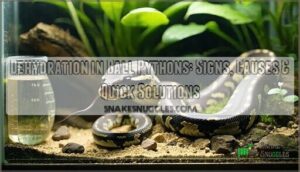This site is supported by our readers. We may earn a commission, at no cost to you, if you purchase through links.
 Dehydration in ball pythons sneaks up fast—think wrinkled skin, dry mouths, and a snake that acts more like a bump on a log than a curious explorer.
Dehydration in ball pythons sneaks up fast—think wrinkled skin, dry mouths, and a snake that acts more like a bump on a log than a curious explorer.
You’ll see it most when humidity drops below 60%, water bowls go empty, or temperatures soar. Sometimes, parasites or feeding only frozen prey add fuel to the fire.
Left unchecked, dehydration can cause stuck sheds, organ trouble, and even shock.
The fix? Keep humidity steady, offer fresh water daily, and try a warm soak if your snake’s looking parched. There’s more to keeping your python healthy than just topping off the water bowl, including maintaining the right environment to prevent dehydration and ensuring your snake stays active and healthy, not just a bump on a log.
Table Of Contents
- Key Takeaways
- Causes of Dehydration in Ball Pythons
- Signs of Dehydration in Ball Pythons
- Risks of Dehydration
- Duration Without Water
- Rehydration Methods and Preventive Measures
- Frequently Asked Questions (FAQs)
- How do ball pythons stay hydrated?
- How can I prevent dehydration in my ball python?
- Can dehydration in ball pythons be fatal?
- Are there any specific signs of dehydration in ball pythons that I should look out for?
- Can dehydrated ball pythons drink too much water?
- How often should water bowls be cleaned?
- What water temperature is safest for drinking?
- Do ball pythons prefer shallow or deep bowls?
- Can tap water cause dehydration in pythons?
- Can dehydration affect a ball python’s lifespan?
- Conclusion
Key Takeaways
- Keep your ball python’s humidity above 60% and change the water daily to prevent dehydration and stuck sheds.
- Look for early signs like wrinkled skin, dry mouth, sunken eyes, or weak movement—these mean your snake needs hydration fast.
- Use only dechlorinated, room-temperature water in a shallow bowl on the cool side of the enclosure.
- Act quickly if you spot trouble—offer a warm soak and fix the environment before dehydration leads to shock or organ damage.
Causes of Dehydration in Ball Pythons
Understanding what causes dehydration in your ball python is essential for maintaining their health and preventing serious complications.
Several environmental and husbandry factors can quickly lead to dangerous fluid loss in these sensitive reptiles, which is a key aspect of their care, involving complete concepts related to their environment.
High Temperature
High temperature is a sneaky culprit behind ball python dehydration.
When Environmental Heating climbs above 32°C, Heat Stress speeds up water loss through skin and breath.
Poor Temperature Control means your python loses hydration fast, showing dehydration symptoms like wrinkled skin and stuck shed.
Proper Thermal Regulation and Warmth Management help prevent ball python dehydration and make dehydration treatment much easier.
Maintaining essential temperature zones is vital for preventing dehydration in ball pythons, ensuring proper care.
Incorrect Humidity
When dealing with proper humidity levels, you’re looking at a critical factor that can make or break your ball python’s health.
Low humidity below 60% doubles dehydration risk, while levels under 50% create serious problems.
Your hygrometer placement should monitor both warm and cool sides accurately. Substrate choice matters—coco husk retains moisture better than paper towels.
Regular enclosure misting helps maintain humidity monitoring, preventing shedding issues that signal snake dehydration before it becomes severe ball python dehydration.
Consistent monitoring prevents respiratory and shedding issues.
Inadequate Water Supply
Why does your ball python’s water bowl matter so much for preventing snake dehydration? An inadequate water supply creates the perfect storm for dehydration symptoms to develop rapidly in your pet.
Proper water bowl management requires attention to several key factors:
- Water dish size should allow your snake to soak completely
- Water change frequency must be every 3-5 days minimum
- Bowl placement on the cool side prevents rapid evaporation
Multiple snakes need separate water sources to avoid contamination. The water source type matters too—use dechlorinated tap water rather than distilled water. You can find a suitable snake dish at online retailers.
Your dehydration prevention strategy depends heavily on consistent, accessible hydration through proper water bowl setup and maintenance.
Parasitic Infections
Several parasites can trigger dehydration in your ball python through different infection routes.
Cryptosporidium and other parasite types cause chronic diarrhea, leading to rapid fluid loss. Mites damage skin, disrupting water retention.
Your reptile vet uses fecal screening and other diagnosis methods to identify infections.
Treatment options include antiparasitic medications like fenbendazole. Prevention strategies involve quarantine protocols and regular health monitoring to protect your snake health from these dehydrating conditions.
Prey Moisture Absorption
Unlike fresh prey that naturally contains body fluids, frozen prey loses significant moisture during the freezing and thawing process.
When you rely solely on prey hydration from frozen prey, you’re basically giving your ball python a "dehydrated meal."
Food soaking techniques can help restore some moisture, but gutloading live prey with water-rich foods provides better hydration.
Consider prey selection carefully – fresh-killed prey offers more natural moisture content than frozen alternatives, supporting proper snake dehydration prevention through improved hydration methods in your ball python diet.
Signs of Dehydration in Ball Pythons
Recognizing dehydration in your ball python early can prevent serious health complications and guarantee your pet’s wellbeing.
You’ll notice several telltale signs that indicate your snake needs immediate attention to restore proper hydration levels.
Wrinkles or Skin Folds
How can you tell if your ball python’s skin is losing its healthy bounce?
When dehydration sets in, your snake’s skin becomes less elastic and develops visible wrinkles or skin folds, particularly around the face and neck areas.
These wrinkled scales serve as clear dehydration symptoms that shouldn’t be ignored.
Skin elasticity naturally decreases when your python lacks proper hydration.
The severity assessment becomes straightforward once you know what to look for.
Dehydration location typically appears first on areas with thinner skin, making the neck and facial regions prime spots for early detection.
- Wrinkle appearance: Gently pinch your snake’s skin – healthy skin snaps back immediately, while dehydrated skin stays tented.
Understanding these ball python dehydration signs helps you catch problems early.
Skin folds that persist after gentle manipulation indicate your snake needs immediate attention.
Preventative skincare starts with maintaining proper humidity levels and providing fresh water access.
Regular monitoring of these physical indicators guarantees your python stays properly hydrated and healthy.
Dry Inner Mouth & Tongue
Something’s off when you peek inside your ball python’s mouth during a routine mouth examination.
A dehydrated snake’s tongue movement becomes sluggish and sticky, while the oral tissues appear dry and tacky.
This oral health indicator is essential for hydration assessment, as healthy pythons maintain moist mouth membranes.
If you notice persistent dryness despite proper humidity, veterinary intervention may be necessary to address underlying snake dehydration and prevent complications.
Food Refusal
When your ball python refuses food, dehydration could be the culprit behind this concerning behavior.
Loss of appetite often signals your snake’s body is struggling with inadequate hydration levels. Dehydrated ball pythons naturally lose interest in eating as their bodies prioritize conserving energy and fluids.
Refusal causes include compromised digestion and reduced metabolic function from poor snake hydration. It’s worth noting that seasonal changes can also affect appetite.
Before offering solutions like appetite stimulants or supplementing diet options, address the underlying ball python hydration issues first. Never resort to force feeding a dehydrated snake, as this worsens their condition and creates dangerous complications.
Weakness
When dehydration strikes your ball python, weakness becomes a telling sign that shouldn’t be ignored. This lethargy signals energy depletion and muscle atrophy that can quickly worsen without intervention.
A weak ball python is a warning sign—act fast before dehydration steals their strength for good
When your ball python loses strength, dehydration is stealing their life force—act fast before weakness becomes irreversible.
Watch for these movement impairment indicators:
- Reduced activity levels and sluggish responses to handling
- Difficulty lifting their head or maintaining normal posture
- Trembling or unsteady movements when attempting to move
These snake dehydration symptoms reveal how ball python dehydration affects their entire system, making immediate rehydration essential, and highlighting the importance of addressing dehydration symptoms and muscle atrophy.
Stuck Shedding
One telltale sign that your ball python’s dehydration has progressed is when shedding becomes a struggle.
You’ll notice stuck shed clinging to areas like the eyes, tail, and nose—a clear indicator that proper humidity levels weren’t maintained during the shedding process.
| Problem Area | What You’ll See |
|---|---|
| Eyes | Cloudy, cracked eye caps that won’t come off |
| Tail tip | Dried skin rings that constrict circulation |
| Nose/face | Flaky patches around nostrils and mouth |
| Body scales | Random patches of old skin stuck to new scales |
This stuck shed happens because dehydration reduces your snake’s ability to complete its natural shedding frequency.
Without adequate moisture, the old skin becomes stubborn and refuses to release properly, potentially causing serious health issues if left untreated.
Risks of Dehydration
When your ball python becomes dehydrated, serious health complications can develop quickly and threaten their survival.
These risks range from immediate dangers like shock to long-term organ damage that requires veterinary intervention.
Shock
When dehydration progresses to severe levels, your ball python faces the life-threatening risk of hypovolemic shock. This occurs when reduced blood volume prevents essential organs from receiving adequate oxygen and nutrients.
Severe dehydration steals your snake’s strength, putting vital organs in danger—act fast before hypovolemic shock sets in
Shock symptoms in ball pythons include:
- Rapid or irregular heartbeat patterns
- Weak pulse and cold body temperature
- Pale or discolored mucous membranes
- Extreme lethargy and unresponsiveness
- Difficulty breathing or gasping
Types of shock from ball python dehydration include circulatory collapse and cardiovascular stress. Without immediate shock treatment through veterinary care, organ failure becomes inevitable.
Preventing shock requires monitoring hydration levels and addressing dehydration treatment promptly. Long-term effects of shock episodes can permanently damage your python’s heart and other organs, making prevention your best defense against severe dehydration.
Eye Infections
When your ball python’s hydration drops, eye infections become a real threat that can steal their sight if you don’t act fast.
Dehydration reduces tear production, compromising your snake’s natural eye defenses and creating perfect conditions for bacterial invaders. Retained eye caps from insufficient moisture trap harmful pathogens against delicate eye tissues.
Watch for these infection symptoms:
- Sunken eyes with visible cloudiness or discharge
- Cracked or dented eye caps that won’t shed properly
- Swelling around the eye area with obvious irritation
Veterinary help provides proper treatment options including antibiotic drops and preventative care guidance to address the eye infections.
Heart Failure
When your ball python’s cardiovascular system faces severe fluid depletion, cardiac function deteriorates rapidly.
Decreased blood pressure from dehydration restricts oxygen delivery, potentially causing dangerous arrhythmias. The heart works harder pumping thickened blood, increasing heart disease risk.
Without prompt fluid therapy using electrolyte solutions, organ damage becomes irreversible. Heart failure represents dehydration’s most life-threatening complication.
Acidosis
When your ball python faces severe dehydration, metabolic acidosis becomes a dangerous reality.
This condition disrupts your pet’s acid-base balance as inadequate water intake causes acidic byproducts to accumulate in their bloodstream.
You’ll notice lowered blood pH compromising enzyme activity and cellular functions.
Kidney function deteriorates, worsening electrolyte imbalance and creating a vicious cycle.
Your snake may develop muscle tremors, extreme lethargy, and organ dysfunction.
Respiratory acidosis can follow as carbon dioxide levels rise.
Immediate fluid therapy with proper electrolyte solution is essential to correct this life-threatening imbalance and prevent fatal outcomes, which can be caused by severe dehydration.
Respiratory Infections
Dry mucosal surfaces from dehydration create perfect breeding grounds for respiratory pathogens in your ball python. When your snake can’t maintain proper hydration, its natural defenses weaken substantially.
RI Symptoms to watch for include:
- Wheezing or rattling sounds during breathing
- Nasal discharge that appears thick or discolored
- Open-mouth breathing patterns
- Labored respiratory effort
- Coughing or sneezing behaviors
- Mucus buildup around nostrils
- Reduced activity levels and appetite loss
RI Causes stem from compromised immune function due to dehydration. RI Treatment requires addressing both the infection and fluid loss simultaneously. RI Prevention depends on maintaining proper humidity levels.
RI Risks increase dramatically when dehydration persists, making your ball python vulnerable to secondary complications. Recognizing these issues early can help prevent serious respiratory failure.
Duration Without Water
You can’t expect your ball python to survive long without water, and the consequences become severe within days.
While these resilient snakes can go weeks without food, dehydration poses a much more immediate threat to their health and survival.
Survival Period
Understanding when snake dehydration becomes life-threatening helps you take Immediate Action. Your ball python can survive 7-12 days without water, though this Dehydration Timeline varies by age and health.
Juveniles face higher dehydration risks due to smaller body mass. After 12 days, ball python dehydration causes severe Organ Damage and systemic shock.
Environmental factors like low humidity accelerate this timeline. Dehydration symptoms appear within the first week, signaling urgent need for intervention.
A key aspect of prevention is maintaining proper humidity and hydration within the enclosure. The Hydration Impact on survival decreases dramatically beyond two weeks, making Long-Term Effects potentially irreversible without proper ball python health management.
Health Consequences
Without proper hydration, your ball python faces serious health consequences that cascade through multiple body systems.
Organ damage becomes inevitable as dehydration strains the kidneys and liver beyond their capacity, while metabolic issues disrupt normal cellular functions.
Impaired immunity leaves your snake vulnerable to infections, and growth stunting affects young pythons particularly hard.
Reduced fertility impacts breeding potential, and these ball python health complications compound quickly once dehydration progresses beyond mild symptoms like sunken eyes and wrinkled skin, leading to severe consequences such as organ damage and growth stunting.
Priority of Water Provision
When your ball python faces dehydration, immediate water provision becomes your top priority.
Proper hydration monitoring helps prevent serious health complications from developing quickly.
- Water bowl placement: Position fresh water on the cool side to reduce evaporation
- Fresh water frequency: Change water every 3-4 days to maintain quality
Ball python dehydration requires swift action.
Your water source quality matters – avoid distilled or softened water that lacks minerals.
Soaking benefits include rapid rehydration and improved circulation.
Monitor your ball python’s hydration daily by checking skin elasticity and eye appearance for early warning signs.
Rehydration Methods and Preventive Measures
When your ball python shows signs of dehydration, quick action can save its life and prevent serious health complications.
The right rehydration techniques combined with proper preventive care will keep your snake healthy and hydrated year-round, which is crucial for its overall well-being and prevent serious health issues.
Rehydration Methods
When your ball python shows signs of dehydration, quick action can save their life.
Here are proven snake rehydration methods that work:
1. Water Soaking Sessions
Prepare lukewarm water at 82-86°F in a shallow container. Soak your python for 20-30 minutes, ensuring their head stays above water. This allows skin absorption of moisture.
2. Electrolyte Baths
Mix diluted Pedialyte or sports drink (75% electrolyte solution, 25% water) for enhanced rehydration. Monitor closely during 30-minute sessions to prevent stress.
3. Strategic Misting Frequency
Increase enclosure humidity through twice-daily misting. Focus on substrate and hide areas rather than directly spraying your snake.
4. Professional Fluid Therapy
Severe cases require veterinary intervention. Vets may use humidity chambers or administer subcutaneous fluids for rapid recovery when home treatments fail. Remember to prioritize species-specific hydration needs for ideal health.
Preventive Measures
Now that we’ve covered how to rehydrate your dehydrated ball python, let’s focus on keeping this situation from happening again. Prevention is always better than treatment in the context of ball python dehydration prevention.
Humidity Control tops the list of preventive measures. You’ll want to maintain humidity levels between 60-70% using a reliable digital hygrometer. To accurately monitor these levels, consider investing in a reliable humidity monitor.
Water Availability means providing fresh water daily in a shallow dish on the cool side of the enclosure. Proper Temperature management prevents excessive water loss – keep that basking spot around 90°F, not hotter. Substrate Choice matters too; moisture-retaining options like coco husk or sphagnum moss help maintain ball python humidity naturally.
Regular Monitoring includes weekly health checks and annual vet visits for fecal exams. Watch for early warning signs like wrinkled skin or behavioral changes.
Essential prevention steps:
- Schedule routine veterinary checkups to catch problems early
- Check humidity and temperature readings daily to stay ahead of issues
These simple snake dehydration prevention steps will keep your ball python healthy and hydrated year-round.
Frequently Asked Questions (FAQs)
How do ball pythons stay hydrated?
Did you know over 40% of captive ball pythons show mild dehydration yearly?
To keep yours hydrated, offer fresh water daily, maintain humidity around 60%, and use moisture-retaining substrates like coco husk or sphagnum moss to ensure proper hydration and environment.
How can I prevent dehydration in my ball python?
You’ll want to keep fresh water available, check humidity with a hygrometer, and mist the enclosure regularly.
Use moisture-retaining substrate, watch for sunken eyes or wrinkled skin, and adjust temperature to prevent drying out.
Can dehydration in ball pythons be fatal?
Dehydration can be fatal for ball pythons if left unchecked.
Without enough fluids, their organs may shut down, leading to serious health issues.
You’ll want to act quickly if you notice any warning signs.
Are there any specific signs of dehydration in ball pythons that I should look out for?
You’ll want to watch for wrinkled skin, sunken eyes, dry mouth, and stuck shed.
If your ball python’s skin doesn’t snap back or its eyes look cracked, it’s time to boost hydration fast.
Can dehydrated ball pythons drink too much water?
Like a sponge soaking up a spill, a dehydrated ball python might gulp water quickly.
Don’t worry if you see this; it’s their way of catching up.
Just keep fresh water available and monitor their recovery.
How often should water bowls be cleaned?
Clean your snake’s water bowl every day, even if it looks spotless.
Fresh water keeps bacteria at bay and encourages drinking.
Think of it as washing your own cup—you wouldn’t reuse it all week, right?
What water temperature is safest for drinking?
Room temperature water, around 75-80°F, works best for your ball python’s drinking needs.
Too cold or too hot can stress them out.
If you wouldn’t drink it, your snake probably shouldn’t either!
Do ball pythons prefer shallow or deep bowls?
You’ll want to use a shallow bowl for your ball python.
They prefer easy access and feel safer with less depth.
A shallow dish also lets them soak without risking their head getting submerged, keeping things stress-free.
Can tap water cause dehydration in pythons?
Hard water, soft water, or chlorinated tap water—each can impact your python’s hydration.
Chlorine or heavy metals in tap water might cause your snake to avoid drinking, leading to dehydration.
Always use dechlorinated, safe water.
Can dehydration affect a ball python’s lifespan?
Yes, dehydration can shorten a ball python’s lifespan.
If you let it go unchecked, organs may fail and your snake could become seriously ill.
Regular hydration and proper humidity help your python live a long, healthy life.
Conclusion
Funny how dehydration in ball pythons can turn your lively pet into a couch potato, isn’t it?
You don’t need a vet degree to spot dry skin or a stuck shed.
Just keep humidity stable, check water bowls daily, and watch for subtle changes.
If your ball python looks off, a warm soak may help.
Staying alert to dehydration keeps your snake healthy, active, and curious, instead of just another bump on a log, by helping you maintain a stable environment.
- https://www.reptifiles.com/ball-python-care-guide/ball-python-diseases-health/ball-python-burn/
- https://reptifiles.com/ball-python-care-guide/ball-python-diseases-health/dehydrated-ball-python/
- https://www.thebiodude.com/blogs/helpful-husbandry-faqs/dehydration-in-reptiles-how-to-prevent-it-and-keep-them-hydrated-appropriately?srsltid=AfmBOoo_r7q3SVookNCmN_6XhZt3_nzKNU3x_jCOY3sV85YZiCSAWrG-
- https://www.justanswer.com/pet-reptile/iwwzm-new-ball-python-seems-little-dehydrated.html
- https://ball-pythons.net/forums/showthread.php?243725-How-long-can-a-ball-python-go-without-water










